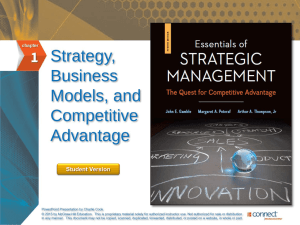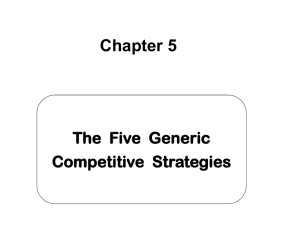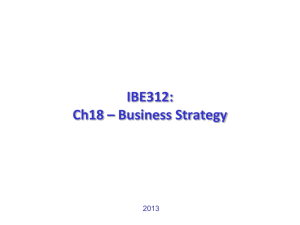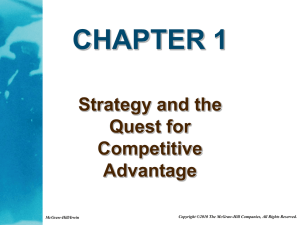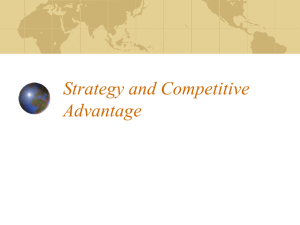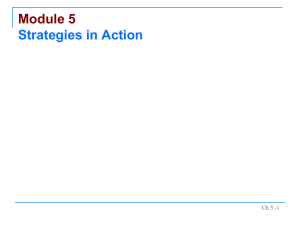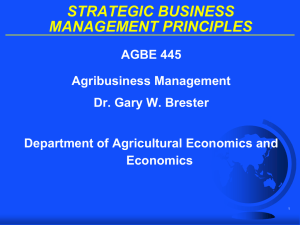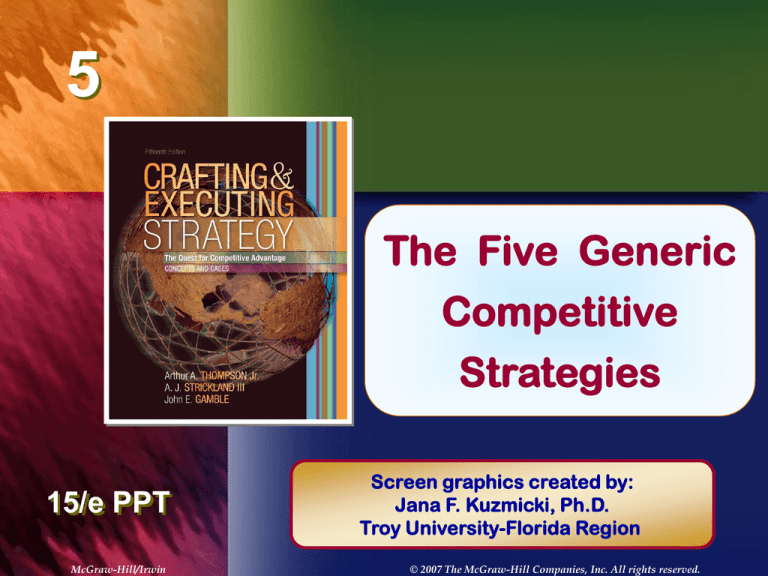
5
TheChapter
Five Generic
Title
Competitive
Strategies
15/e PPT
McGraw-Hill/Irwin
Screen graphics created by:
Jana F. Kuzmicki, Ph.D.
Troy University-Florida Region
© 2007 The McGraw-Hill Companies, Inc. All rights reserved.
“Competitive strategy is about
being different. It means
deliberately choosing to perform
activities differently or to perform
different activities than rivals to
deliver a unique mix of value.”
Michael E. Porter
5-2
Chapter Roadmap
The
Five Competitive Strategies
Low-Cost
Broad
Provider Strategies
Differentiation Strategies
Best-Cost
Focused
Provider Strategies
(or Market Niche) Strategies
The
Contrasting Features of the Five Generic
Competitive Strategies: A Summary
5-3
Strategy and Competitive Advantage
advantage exists when a firm’s
strategy gives it an edge in
Competitive
Attracting customers and
Defending against competitive forces
Key to Gaining a Competitive Advantage
Convince
customers firm’s product / service offers
superior value
A good product at a low price
A superior product worth paying more for
A best-value product
5-4
What Is Competitive Strategy?
Deals
exclusively with a company’s business
plans to compete successfully
Specific efforts to please customers
Offensive and defensive moves
to counter maneuvers of rivals
Responses to prevailing market conditions
Initiatives to strengthen its market position
Narrower
in scope than business strategy
5-5
Fig. 5.1: The Five Generic Competitive Strategies
5-6
Low-Cost Provider Strategies
Keys to Success
Make
achievement of meaningful lower costs
than rivals the theme of firm’s strategy
Include
features and services in product
offering that buyers consider essential
Find
approaches to achieve a cost advantage
in ways difficult for rivals to copy or match
Low-cost leadership means low overall costs, not
just low manufacturing or production costs!
5-7
Translating a Low-Cost Advantage into
Higher Profits: Two Options
Option 1: Use lower-cost edge to
under-price competitors and attract
price-sensitive buyers in enough
numbers to increase total profits
Option 2: Maintain present price, be
content with present market share,
and use lower-cost edge to earn a
higher profit margin on each unit sold,
thereby increasing total profits
5-8
Nucor Corporation’s
Low-Cost Provider Strategy
Eliminate some production processes from value chain used by traditional
integrated steel mills; cut investment in facilities and equipment
Strive hard for continuous improvement in the efficiency of its plants and
frequently invest in state-of-the art equipment to reduce unit costs
Carefully select plan sites to minimize inbound and outbound shipping
costs and to take advantage of low rates for electricity
Hire a nonunion workforce that uses team-based incentive compensation
systems
Heavily emphasize consistent product quality and maintain rigorous quality
systems
Minimize general and administrative expenses by maintaining a lean staff at
corporate headquarters and allowing only 4 levels of management
5-9
Approaches to Securing
a Cost Advantage
Approach 1
Do a better job than rivals of
performing value chain activities
efficiently and cost effectively
Approach 2
Revamp value chain to bypass
cost-producing activities that add little
value from the buyer’s perspective
5-10
Control
costs!
By-pass
costs!
Approach 1: Controlling the Cost Drivers
Capture scale economies; avoid scale diseconomies
Capture learning and experience curve effects
Control percentage of capacity utilization
Pursue efforts to boost sales and spread costs such as R&D
and advertising over more units
Improve supply chain efficiency
Substitute use of low-cost for high-cost raw materials
Use online systems and sophisticated software to achieve
operating efficiencies
Adopt labor-saving operating methods
Use bargaining power to gain concessions from suppliers
Compare vertical integration vs. outsourcing
5-11
Approach 2: Revamping the Value Chain
Use
direct-to-end-user sales/marketing methods
Make
greater use of online technology applications
Streamline
operations by eliminating low-valueadded or unnecessary work steps
Relocate
Offer
facilities closer to suppliers or customers
basic, no-frills product/service
Offer
a limited product/service as opposed to a full
product/service line
5-12
Wal-Mart’s Approach to
Managing Its Value Chain
Institute extensive information sharing with vendors via online
systems
Pursue global procurement of some items and centralize most
purchasing activities
Invest in state-of-the-art automation at its distribution centers
Strive to optimize the product mix and achieve greater sales turnover
Install security systems and store operating procedures that lower
shrinkage rates
Negotiate preferred real estate rental and leasing rates with real
estate developers and owners of its store sites
Manage and compensate its workforce in a manner to yield lower
labor costs
5-13
Keys to Success in Achieving
Low-Cost Leadership
Scrutinize each cost-creating activity, identifying cost drivers
Use knowledge about cost drivers to manage
costs of each activity down year after year
Find ways to restructure value chain to eliminate
nonessential work steps and low-value activities
Work diligently to create cost-conscious corporate cultures
Feature broad employee participation in continuous costimprovement efforts and limited perks for executives
Strive to operate with exceptionally small corporate staffs
Aggressively pursue investments in resources and
capabilities that promise to drive costs out of the business
5-14
Characteristics of a Low-Cost Provider
Cost
conscious corporate culture
Employee
participation in cost-control efforts
Ongoing
efforts to benchmark costs
Intensive
scrutiny of budget requests
Programs
promoting continuous cost improvement
Successful low-cost producers champion
frugality but wisely and aggressively
invest in cost-saving improvements !
5-15
When Does a Low-Cost
Strategy Work Best?
Price
competition is vigorous
Product is standardized or readily available
from many suppliers
There are few ways to achieve
differentiation that have value to buyers
Most buyers use product in same ways
Buyers incur low switching costs
Buyers are large and have
significant bargaining power
Industry newcomers use introductory low prices to
attract buyers and build customer base
5-16
Pitfalls of Low-Cost Strategies
Being
Low
overly aggressive in cutting price
cost methods are easily imitated by rivals
Becoming
too fixated on reducing costs
and ignoring
Buyer interest in additional features
Declining buyer sensitivity to price
Changes in how the product is used
Technological
breakthroughs open up cost
reductions for rivals
5-17
Test Your Knowledge
Striving to be the industry’s low-cost provider and achieving
lower costs than rivals entails
A. doing a better job than rivals of performing value chain
activities more cost-effectively.
B. having a smaller labor force than rivals, paying lower wages
than rivals, locating all facilities in countries where labor costs
are low, and outsourcing many value chain activities to
suppliers with world-class technological capabilities.
C. revamping the firm’s overall value chain to eliminate or bypass
cost-producing activities that produce little value added
insofar as customers are concerned.
D. adopting activity-based costing, utilizing more best practices
than rivals, and having a narrower product line than rivals.
E. Both A and C.
5-18
Differentiation Strategies
Objective
Incorporate
differentiating features that cause
buyers to prefer firm’s product or service over
brands of rivals
Keys to Success
Find
ways to differentiate that create value for
buyers and are not easily matched or cheaply
copied by rivals
Not
spending more to achieve differentiation
than the price premium that can be charged
5-19
Benefits of Successful Differentiation
A product / service with unique,
appealing attributes allows a firm to
Command a premium price and/or
Increase unit sales and/or
Build brand loyalty
Which
hat is
unique?
= Competitive Advantage
5-20
Types of Differentiation Themes
Unique taste – Dr. Pepper
Multiple features – Microsoft Windows and Office
Wide selection and one-stop shopping – Home Depot,
Amazon.com
Superior service -- FedEx, Ritz-Carlton
Spare parts availability – Caterpillar
Engineering design and performance – Mercedes, BMW
Prestige – Rolex
Product reliability – Johnson & Johnson
Quality manufacture – Karastan, Michelin, Toyota
Technological leadership – 3M Corporation
Top-of-line image – Ralph Lauren, Starbucks, Chanel
5-21
Sustaining Differentiation:
Keys to Competitive Advantage
Most
appealing approaches to differentiation
Those
hardest for rivals to match or imitate
Those
buyers will find most appealing
Best
choices to gain a longer-lasting, more
profitable competitive edge
New
product innovation
Technical
Product
superiority
quality and reliability
Comprehensive
Unique
customer service
competitive capabilities
5-22
Where to Find Differentiation
Opportunities in the Value Chain
Purchasing
Product
and procurement activities
R&D and product design activities
Production
process / technology-related activities
Manufacturing
/ production activities
Distribution-related
Marketing,
Activities,
Costs, &
Margins of
Suppliers
activities
sales, and customer service activities
Internally
Performed
Activities,
Costs, &
Margins
Activities, Costs,
& Margins of
Forward Channel
Allies &
Strategic Partners
5-23
Buyer/User
Value
Chains
How to Achieve a
Differentiation-Based Advantage
Approach 1
Incorporate product features/attributes that
lower buyer’s overall costs of using product
Approach 2
Incorporate features/attributes that raise the
performance a buyer gets out of the product
Approach 3
Incorporate features/attributes that enhance buyer
satisfaction in non-economic or intangible ways
Approach 4
Compete on the basis of superior capabilities
5-24
Test Your Knowledge
Which of the following is not one of the four basic routes to
achieving a differentiation-based competitive advantage?
A. Appealing to high-income buyers who are willing and able to
pay a premium price for a high-performing, multi-featured
product
B. Incorporating features that raise product performance
C. Incorporating product attributes and user features that lower
the buyer’s overall costs of using the company’s product
D. Delivering value to customers via competencies and
competitive capabilities that rivals don’t have or can’t afford to
match
E. Incorporating features that enhance buyer satisfaction in
intangible or non-economic ways
5-25
Importance of Perceived Value
Buyers
Price
seldom pay for value that is not perceived
premium of a differentiation strategy reflects
Value actually delivered to the buyer
and
Value perceived by the buyer
Actual
and perceived value can differ when buyers
are unable to assess their experience with a
product
5-26
Signaling Value as Well
as Delivering Value
Incomplete knowledge of buyers causes them to
judge value based on such signals as
Price
Attractive packaging
Extensive ad campaigns
Ad content and image
Seller facilities or professionalism and
personality of employees
Having a list of prestigious customers
Signals of value may be as important as
actual value when
Nature of differentiation is hard to quantify
Buyers are making first-time purchases
Repurchase is infrequent
Buyers are unsophisticated
5-27
When Does a Differentiation
Strategy Work Best?
There
are many ways to differentiate a product
that have value and please customers
Buyer
needs and uses are diverse
Few
rivals are following a similar
differentiation approach
Technological
change and
product innovation are fast-paced
5-28
Pitfalls of Differentiation Strategies
Appealing product features are easily copied by rivals
Buyers see little value in unique attributes of product
Overspending on efforts to differentiate the product
offering, thus eroding profitability
Over-differentiating such that product
features exceed buyers’ needs
Charging a price premium
buyers perceive is too high
Not striving to open up meaningful gaps in quality,
service, or performance features vis-à-vis rivals’
products
5-29
For Discussion: Your Opinion
A low-cost provider strategy can defeat a
differentiation strategy when buyers are satisfied with
a basic product and don’t think “extra” attributes are
worth a higher price. True or false? Explain.
5-30
Best-Cost Provider Strategies
Combine
a strategic emphasis on low-cost with
a strategic emphasis on differentiation
Make an upscale product at a lower cost
Give customers more value for the money
Objectives
Deliver superior value by meeting or exceeding
buyer expectations on product attributes and
beating their price expectations
Be
the low-cost provider of a product with good-toexcellent product attributes, then use cost
advantage to underprice comparable brands
5-31
Competitive Strength of a
Best-Cost Provider Strategy
provider’s competitive advantage is
based on its capability to include upscale attributes
at a lower cost than rivals’ comparable products
To achieve competitive advantage,
a company must be able to
A best-cost
Incorporate attractive features at a lower cost than rivals
Manufacture a good-to-excellent quality product at a
lower cost than rivals
Develop a product that delivers good-to-excellent
performance at a lower cost than rivals
Provide attractive customer
service at a lower cost than rivals
5-32
When Does a Best-Cost
Provider Strategy Work Best?
Where
buyer diversity makes
product differentiation the norm and
Where
many buyers are also
sensitive to price and value
5-33
Risk of a Best-Cost Provider Strategy
A best-cost
provider may get squeezed between
strategies of firms using low-cost and
differentiation strategies
Low-cost leaders may be able to siphon
customers away with a lower price
High-end differentiators may be able to
steal customers away with better product attributes
5-34
Test Your Knowledge
Which of the following are distinguishing features of a bestcost provider strategy (based on the comparisons of the five
generic competitive strategies shown in Figure 5.1)?
A. The strategic target is price-conscious buyers
B. A marketing emphasis on charging a slightly higher price than
rival brands having comparable features and attributes
C. A product line that stresses wide selection, many product
variations, and emphasis on differentiating features
D. A competitive advantage based on more value for the money
E. Using constant product innovation, excellent R&D skills, and
periodic technological breakthroughs to sustain the strategy
5-35
Focus / Niche Strategies
Involve
concentrated attention on a narrow piece of
the total market
Objective
Serve niche buyers better than rivals
Keys to Success
Choose
a market niche where buyers
have distinctive preferences, special
requirements, or unique needs
Develop
unique capabilities to serve
needs of target buyer segment
5-36
Approaches to Defining a Market Niche
Geographic
uniqueness
Specialized
requirements in
using product/service
Special
product attributes
appealing only to niche buyers
5-37
Examples of Focus Strategies
Animal
Planet and History Channel
Cable TV
Google
Internet search engines
Porsche
Sports cars
Cannondale
Top-of-the line mountain bikes
Enterprise
Rent-a-Car
Provides rental cars to repair garage customers
Bandag
Specialist in truck tire recapping
5-38
Focus / Niche Strategies
and Competitive Advantage
Approach 1
Achieve
lower costs than rivals in
serving a well-defined buyer segment –
Focused low-cost strategy
Approach 2
Offer
Which
hat is
unique?
a product appealing to unique
preferences of a well-defined buyer segment –
Focused differentiation strategy
5-39
What Makes a Niche
Attractive for Focusing?
Big
enough to be profitable and offers good growth
potential
Not
crucial to success of industry leaders
Costly
or difficult for multi-segment competitors
to meet specialized needs of niche members
Focuser
has resources and capabilities
to effectively serve an attractive niche
Few
other rivals are specializing in same niche
Focuser
can defend against challengers via
superior ability to serve niche members
5-40
Risks of a Focus Strategy
Competitors
find effective ways to match
a focuser’s capabilities in serving niche
Niche
buyers’ preferences shift towards product
attributes desired by majority of buyers – niche
becomes part of overall market
Segment
becomes so attractive it becomes
crowded with rivals, causing segment profits to be
splintered
5-41
For Discussion: Your Opinion
Which of the five generic competitive strategies do
you think the following companies are employing:
The Saturn division of General Motors
Abercrombie & Fitch
Amazon.com
Avon Products
5-42
Deciding Which Generic
Competitive Strategy to Use
Each positions a company differently in its market and
competitive environment
Each establishes a central theme for how a company will
endeavor to outcompete rivals
Each creates some boundaries for maneuvering as market
circumstances unfold
Each points to different ways of experimenting with the
basics of the strategy
Each entails differences in product line, production
emphasis, marketing emphasis, and means to sustain the
strategy
The big risk – Selecting a “stuck in the middle” strategy!
This rarely produces a sustainable competitive
advantage or a distinctive competitive position!
5-43
5-44

